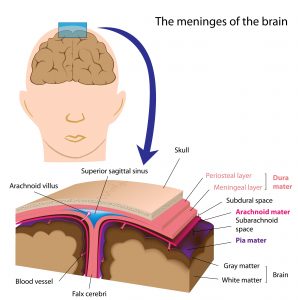The brain has several forms of protection from injury. First is the skull which is composed of thick bone. Between the skull and the brain itself are three protective membranes, the meninges:
- Dura mater: a thick layer of tissue attached to the skull and forming sheets between the two cerebral hemispheres (the falx cerebri) and between the cerebrum and cerebellum (the tentorium cerebelli).
- Arachnoid mater: a thinner layer (called arachnoid as like a spider’s web) separate from the dura.
- Pia mater: a thin layer closely applied to the brain itself.

Between the arachnoid mater and the pia mater there is a space called the subarachnoid space. This space is filled with fluid called cerebrospinal fluid (CSF). This provides another layer of protection for the brain. CSF also fills four additional spaces called the ventricles.
CSF is produced by filtering blood through a network of blood vessels in the ventricles called the choroid plexus. CSF is produced continuously; it circulates around the brain and spinal cord and then drains back into the bloodstream via swellings called arachnoid villi which protrude into the big venous sinuses (channels) in the skull.
When the circulation of CSF is blocked the fluid builds up inside the skull resulting in hydrocephalus.